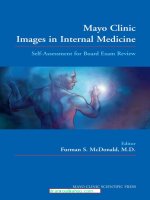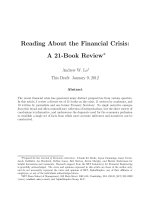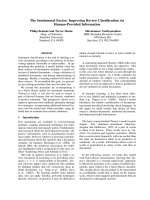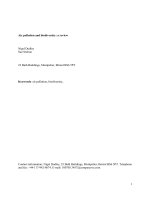Microeconomics Review.docx
Bạn đang xem bản rút gọn của tài liệu. Xem và tải ngay bản đầy đủ của tài liệu tại đây (180.78 KB, 59 trang )
MICROECONOMICS REVIEW
1. Beef is a normal good. You observe that both the equilibrium price and quantity of beef have fallen
over time. Which of the following explanations would be most consistent with this observation?
a. Consumers have experienced an increase in income and beef-production technology has
improved.
b. The price of chicken has risen and the price of steak sauce has fallen.
c. New medical evidence has been released that indicates a negative correlation between a
person’s beef consumption and his or her longevity.
d. The demand curve for beef must be positively sloped.
2. During the last few decades in the United States, health officials have argued that eating too much beef
might be harmful to human health. As a result, there has been a significant decrease in the amount
of beef produced. Which of the following best explains the decrease in production?
a. Beef producers, concerned about the health of their customers, decided to produce
relatively less beef.
b. Government officials, concerned about consumer health, ordered beef producers to
produce relatively less beef.
c. Individual consumers, concerned about their own health, decreased their demand for beef,
which lowered the equilibrium price of beef, making it less attractive to produce.=> P
decreases
d. Anti-beef protesters have made it difficult for both buyers and sellers of beef to meet in
the marketplace.
3. Which of the following events would unambiguously (clear) cause a decrease in the equilibrium price
of cotton shirts?
a. an increase in the price of wool shirts and a decrease in the price of raw cotton
b. a decrease in the price of wool shirts and a decrease in the price of raw cotton
c. an increase in the price of wool shirts and an increase in the price of raw cotton
d. a decrease in the price of wool shirts and an increase in the price of raw cotton
4. Which of the following events would cause the price of oranges to fall?
a. There is a shortage of oranges.
b. An article is published in which it is claimed that tangerines cause a serious disease, and
oranges and tangerines are substitutes.
c. The price of land throughout Florida decreases, and Florida produces a significant
proportion of the nation’s oranges.
d. All of the above are correct.
5. Which of the following events would definitely result in a higher price in the market for Snickers?
a. Demand for Snickers increases and supply of Snickers decreases.
b. Demand for Snickers and supply of Snickers both decreases.
c. Demand for Snickers decreases and supply of Snickers increases.
d. Demand for Snickers and supply of Snickers both increase
6. Which of the following sets of events would most likely cause an increase in the price of a new house?
a. higher wages for carpenters, higher wood prices, increases in consumer incomes, higher
apartment rents, increases in population, and expectations of higher house prices in the
future
b. lower wages for carpenters, lower wood prices, increases in consumer incomes, higher
apartment rents, increases in population and expectations of higher house prices in the
future
c. lower wages for carpenters, higher wood prices, decreases in consumer incomes, higher
apartment rents, decreases in population and expectations of higher house prices in the
future
d. higher wages for carpenters, lower wood prices, decreases in consumer incomes, lower
apartment rents, decreases in population and expectations of lower house prices in the
future
Table 5-1
Good
A
Price Elasticity of
Demand
1.3
Factors
Less elastic
B
2.1
More elastic
Few substitute/ Broadly defined market/ Portions
in income to buy/short-run/necessary
9. Refer to Table 5-1. Which of the following is consistent with the elasticities given in Table 5-1?
a. A is a luxury and B is a necessity.
b. A is a good several years after a price increase, and B is that same good several days after
the price increase.
c. A is a Kit Kat bar and B is candy.
d. A has fewer substitutes than B.
10. Refer to Table 5-1. Which of the following is consistent with the elasticities given in Table 5-1?
a. A is grapes and B is fruit.
b. A is T-shirts and B is socks.
c. A is train tickets before cars were invented, and B is train tickets after cars were invented.
d. A is diamond necklaces and B is beds.
Table 5-2
The following table shows a portion of the demand schedule for a particular good at various levels of
income.
Price
$24
$20
$16
$12
$8
$4
Quantity Demanded
(Income = $5,000)
2
4
6
8
10
12
Quantity Demanded
(Income = $7,500)
3
6
9
12
15
18
Quantity Demanded
(Income = $10,000)
4
8
12
16
20
24
11. Refer to Table 5-2. Using the midpoint method, when income equals $7,500, what is the price
elasticity of demand between $16 and $20?
a. 0.56
b. 0.75
c. 1.33
d. 1.80
12. Refer to Table 5-2. Using the midpoint method, when income equals $5,000, what is the price
elasticity of demand between $8 and $12?
a. 0.56
b. 0.75
c. 1.33
d. 1.80
13. Refer to Table 5-2. Using the midpoint method, at a price of $16, what is the income elasticity of
demand when income rises from $5,000 to $10,000?
a. 0.00
b. 0.50
c. 1.00
d. 1.50
14. Refer to Table 5-2. Using the midpoint method, at a price of $8, what is the income elasticity of
demand when income rises from $7,500 to $10,000?
a. 0.00
b. 0.41
c. 1.00
d. 2.45
15. Refer to Table 5-2. Using the midpoint method, at a price of $12, what is the income elasticity of
demand when income rises from $5,000 to $10,000?
a. 0.00
b. 0.41
c. 1.00
d. 2.45
Scenario 12-5
Samantha has been working for a law firm and earning an annual salary of $80,000. She decides to open
her own practice. Her annual expenses will include $15,000 for office rent, $3,000 for equipment rental,
$1,000 for supplies, $1,200 for utilities, and a $35,000 salary for a secretary/bookkeeper. Samantha will
cover her start-up expenses by cashing in a $20,000 certificate of deposit on which she was earning
annual interest of $500.
16. Refer to Scenario 12-5. Samantha's annual implicit costs will equal
a. $55,200.
b. $75,200.
c. $80,500.
d. $165,700.
17. Refer to Scenario 12-5. Samantha's annual accounting costs will equal
a. $55,200.
b. $75,200.
c. $80,500.
d. $165,700.
18. Refer to Scenario 12-5. Samantha's annual economic costs will equal (implicit + accounting costs)
a. $55,200.
b. $75,200.
c. $80,500.
d. $135,700.
19. Refer to Scenario 12-5. According to Samantha’s accountant, which of the following revenue
totals will yield her business $50,000 in profits? Accounting profit= Revenue – Accounting cost
a. $55,200.
b. $105,200.
c. $132,500.
d. $185,700.
20. Refer to Scenario 12-5. According to an economist, which of the following revenue totals will
yield her business $50,000 in economic profits? Economic profit = Revenue – Economic cost
a. $55,200.
b. $100,200.
c. $132,500.
d. $185,700.









